Live Bee Swarm Removal And Relocation
Succuesfull Bee Relocations After Removal
Live Bee Removals This Year
Live Bee Swarm Removals This Year
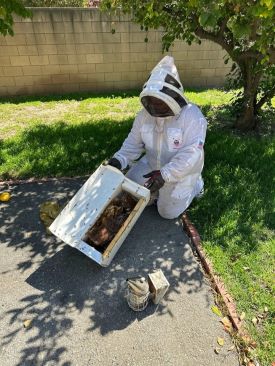
Live Bee Swarm Removal is an important and delicate process that should be handled by professionals. Bees can become aggressive if disturbed and tend to stay close to their colony. APA BEE REMOVAL offers safe and same-day removal and relocation services at an affordable rate. Their method prioritizes the well-being of the bees, using natural and humane techniques that avoid chemicals or vacuums. The removed bees are either relocated to a farm or donated to local beekeepers, ensuring their continued care. When people get unwanted bees on their property, they often look to remove the bees by calling, a beekeeper, pest control, or bee removal company, for a Live Bee swarm Removal. So what exactly is “ live bee swarm removal”. But be warned there are actually several types and ways of performing a "live" bee swarm removal. Lets break these down first:
Type 1 = Live Bee Removal (without pesticides)
Live Bee Removal (without pesticides): This type of bee removal can be misleading. Technically the bees are removed alive, but that doesn’t always mean they will survive. Unfortunately there are some people in the industry that mislead people by claiming they perform live removal, but they don’t actually save the bees. These companies often use shop vacs (or vacuums that are not modified to be gentle). The problem with regular vacuums is that the bees become injured when they are sucked up into the chamber of the vacuum. Only a fraction of the bees survive, which inevitably causes the entire colony to die off. Technically these companies are not lying. It is technically a live removal…but it sure isn’t humane.
Type 2 = Live Bee Removal Catch and Release
The next type of bee removal is one where the bees are removed alive in a humane way, but not necessarily looked after or cared for afterward. Companies that perform this type of bee removal often do not have a place to put the bees. It is because they do not have the land or space to set up beehive boxes.
Type 3 = Live Bee Removal With Relocation
This type of bee removal is when a company or bee professional not only removes the bees humanely, but also relocates them to a beehive box. In other words, the bees are not dumped randomly or illegally, but placed in a reserved spot, hopefully in a proper beehive box. The problem with this type of bee removal is that it does not ensure that the bees will have enough food and water. They are often not re queened to control aggression. In other words, they are simply left on their own, to prosper or thrive on their own. No care is given to help ensure the colonies continued survival. This type of bee removal is better than the previous two, but the next type is the one all people should seek out when looking for a humane bee removal company.
Type 4 = Live and Humane Bee Removal With Relocation And Care Taking
This last type of live bee removal is all about sustainability. It is the truest form of a live and humane taken to an apiary, farm, or beekeeper, where they will be cared for. In this scenario, the bees are tended to (usually at least bi-weekly). The beekeeper will perform regular hive inspections to ensure the health of the colony. Water and food are often provided if not available by nature. This is what most people think of when they think about Live Bee Removal, but sadly it is not very common in the bee removal industry.
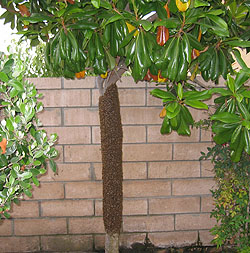
Bee Swarms
First of all, DON’T PANIC if you’re seeing a swarm of bees. Generally swarms of bees are fairly docile and not looking to sting anyone. When a bee colony gets too big for its existing space they swarm to send excess population to start new colonies. Occasionally the entire population of a colony “absconds” due to undesireable conditions, and absconding swarms can be much more prone to stinging, so it is best to stay on the safe side and give them their space. Swarms have a tendency to stop and rest on just about anything they can find, especially trees. Each swarm will have one queen bee in it. In preparation for swarming the mother colony starts raising new queens. When the new queens hatch, one of the queens will leave with a portion of the bees to find a new home. Typically, the older queen leaves with the swarm. In the case of Africanized bees this can happen multiple times a day during the spring or other good weather conditions. Swarms can come in a range of sizes. When they land you may see a cluster the size of a grapefruit on the small end up to the size of a basketball on the larger end. Sometimes a swarm will look conical in shape. While the swarm is resting scout bees will be coming and going from it looking for a good location for a more permanent home. They will be looking for a hollow cavity such as a wall void or roof, because they do not like to nest out in the open where they are not protected from the elements. It is a good idea to keep a close eye on your property after a swarm passes, but remember that the presence of a swarm doesn’t necessarily mean they will decide to nest anywhere close to you. Do NOT attempt to convince these bees to leave or ‘hurry them up’ by spraying them with water or household bug sprays, smoking them or other silly ideas from the Internet. They are highly organized and will not leave until their scouts have come back to tell them where they are going. Disturbing them in this state will only cause confusion and a mess — picture that mass of bees flying all around the area, because that’s what’s going to happen! Also note that if the queen bee is damaged and she cannot fly, they will not leave her behind! If you are not comfortable waiting for them to leave on their own give us a call!
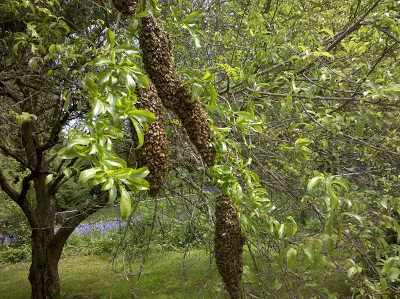
Why Do Honey Bees Swarm?
Swarms are the method by which honey bee colonies reproduce. 20-50% of the colony leaves the hive with the old queen, landing within a couple hundred feet of the hive they left from. They usually end up on tree branches, but sometimes they'll decide to land elsewhere, such as on mailboxes, cars, fences, door handles or anything else you can think of. This is only temporary, though, as the colony sends out scouts to find a new, permanent home. This is often a tree cavity, but any sufficiently large and dry cavity is suitable. Honey bees often choose wall cavities in houses because they are safe, dry places in which they can thrive.
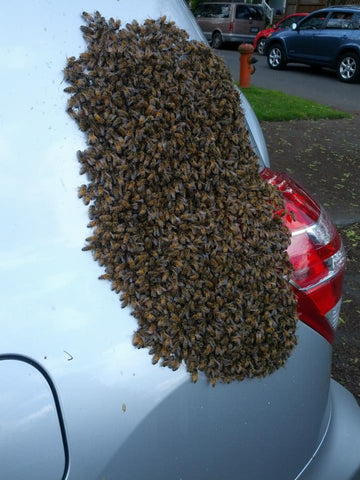
How To Identify a Honeybee Swarm?
How to identify a honeybee swarm: Other insects a like wasps, yellow jackets, and bumble bees are often mistaken for honeybees. A swarm of honeybees have a few distinct features you can look out for. Individual bees have fuzzy black and gold bodies, and the swarm overall will appear as a distinctive, hanging clump. This clumping behavior makes it possible for beekeepers to gently collect and transport the bees.
Why We Care About Bees?

Scout Bees
Scout bees are very fascinating and illustrate just how smart bees are. Scout bees will go out ahead of a swarm to find new nesting locations. They check the area for size, temperature, etc. These bees utilize amazing communication methods. They use the sun to navigate, and communicate using pheromones (smells) produced by their bodies. These are nature’s perfumes, and are undetectable to humans. They even do dances for each other to illustrate directions! Sometimes a few scouts on your property will result in no major situation at all, but sometimes they decide to bring all their friends to the party at your house! If you see bees in a particular location for more than a couple days it is time to call a professional. Once the whole swarm shows up and moves in they will get to work pretty quick! It will only take a few days for the girls to start building some combs. To help identify if you have a problem look for ‘direct flight’ where the bees are disappearing into a cavity space. It will appear like freeway traffic in and out of a specific location like a crack or a crevice. Deterrent treatments in scouting situations can be done to help prevent the swarm from arriving.
Live Bee Swarm Removal and Relocation from a Bush or Tree
Live Bee Swarm removal and relocation is one delicate theme, because Bee swarms could be more aggressive but only if they are bothered. They are located within 100 yards of the colony and once they have been seen, again, the most important thing to do is contact as soon as possible professionals like our team. We can prevent future attacks or the construction of a hive in a non-convenient place like homes or near homes. We can safely remove and relocate a swarm of bees hanging from your tree or bush. If your swarm just arrived please don’t be alarmed. Please do not bother or try to harm them. We will remove and relocate them for a low flat rate. We offer same day service.
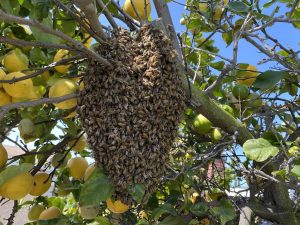
Bees are an amazing asset to our environment because they pollinate plants and help our ecosystem thrive. While bees benefit our ecosystem, you do not want them building a hive on your property. Since bees are known to be vicious defenders of their hives, having a hive in your yard can threaten you and your family. Bees can be dangerous to anyone, but the risk of danger for those with bee sting allergies can be life-threatening.
At APA Bee Removal our customers’ satisfaction has always been our number one priority, and it shows in our ratings!
Offering prompt same-day or next-day service on our bee services, you’ll get treatment as soon as you need it!
We utilise bee removal solutions, taking a more environmentally conscious and safe approach to pest management.
Customer satisfaction is our priority. Prepare to witness quality and integrity.
Trustindex verifies that the original source of the review is Google. The removal expert did a great job today. Answered all of my questions during the removal process. He has 25 years of experience and it showed. I even got some of the honey.Posted onTrustindex verifies that the original source of the review is Google. I found 4 wasp nests at my backdoor and window. I googled beekeeper and found APA BEE REMOVAL. A beekeeper came over 1.5 hous after I gave them a call on weekend. He is quick and efficient. The nests were removed completely and I was told that I have a warranty period of 30 days. I was charged $200 for the service. I appreciate the proficiency and quick responsiveness from APA BEE REMOVAL. I recommend them if you happen to encounter the similar problem for your house.Posted onTrustindex verifies that the original source of the review is Google. Came to my parents home for 4th of July. Notice where bees going in the roof area of the garage. Alex so awsome, friendly and very knowledgeable. came removed the bees and also did the repair. Iam so happy because i hought we would have a hardtime to find someone on a holiday and to respond so quickly. the process was so easy.Posted onTrustindex verifies that the original source of the review is Google. On May 26, 2025, we saw a bee swarm in our orange tree.. called this company and they were out to our house within hours to remove it.. he was so nice and professional.. as of this morning no more bee.. hats off look at the size of the bee swarm Thank you so muchPosted onTrustindex verifies that the original source of the review is Google. He was great. Very professional friendly, and kept us informed of everything he had to do He worked fast and got the job done in about two hours Would definitely use them againPosted onTrustindex verifies that the original source of the review is Google. Called them at one in the morning. They were here within an hour. Quick service friendly will definitely use them again.!Posted onTrustindex verifies that the original source of the review is Google. Had great experience with this company great customer servicePosted onTrustindex verifies that the original source of the review is Google. Gracias a APA BEE. REMOVAL me ayudaron con una colmena que tenía dentro de la pared de mi casa son gente muy buena y profesional los recomiendo muchoPosted onTrustindex verifies that the original source of the review is Google. Alex is amazing, knowledgeable, efficient, and handled bees swiftly. Removed 50 pounds of honey comb and honey.Posted onTrustindex verifies that the original source of the review is Google. Great service at a reasonable price. Alex is super professional and friendly. For our roof top, he had to rent a lift to do the job, The price was reasonable and did a fantastic job putting back the roof. They seem to be really busy, so have a little patient.
